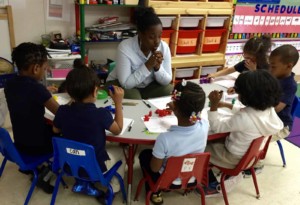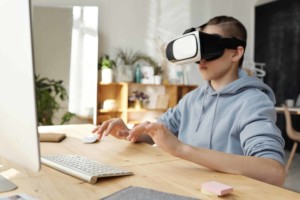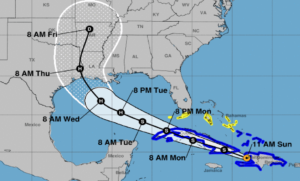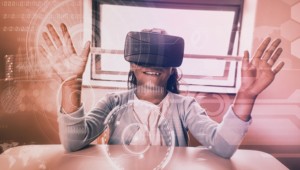Augmented Reality in Kindergarten?

By: Katrina Youdale
Over the last decade, the education sector has experienced enormous change. Amidst this, one of the most contended areas of discussion has been around the introduction of technology to children as young as 3. The adoption of STEM education across the globe has quickly filtered down to our littlest learners.
Don’t worry kids will still come home with sand in their pockets.
Early childhood is a critical time for the development of core skills that establish lifelong foundations. Despite all the conflicting device advice, fine motor, writing and reading remain essential skills with early childhood organizations also reiterating the importance of social skills at this age.
The introduction of STEM to Early Childhood Education (ECE) may sound daunting but the principles of STEM center around solving real-world problems through collaboration and hands-on inquiry. There’s no one right answer and failure is important. If you’ve ever tried a craft with 3-year-old boys this sounds perfect!
Of the core STEM subject areas, technology is the new kid on the block. With that comes challenges for teachers and parents. There is a lack of quality content, it can be expensive to invest in technology tools and there is limited time and support in the classroom to install, integrate, support and get up to speed.
There is also a stigma attached with technology use at this age, that it is isolating and comes at the cost of other essential things like climbing trees, collecting flowers and building robots from tissue boxes. Children are being born into a digital society and the assumption needs to be made that kindergarten children are in an environment of care and are guided by qualified teachers with respect as to how and when they use technology.
AR presents opportunities to the Early Childhood that can’t be ignored.
For those of you that think it all sounds a bit George Jetson, no you don’t need headgear or goggles or a jetpack for that matter. Don’t confuse it with VR. AR and VR are like non-identical twins. They are always mentioned together, they are often mistaken for other yet considered the same but are fundamentally quite different.
Virtual Reality (VR) to date has had a greater profile, gained its popularity through gaming and you need to invest in headsets and supporting hardware. 94% of UK teachers think that VR will be beneficial in the classroom, shown by a Lenovo report. 42% predict that it will be commonplace within 5 years. VR is not aimed at ECE with major manufacturers of VR headsets marketing them as being appropriate for children over 13 years of age.
Augmented Reality (AR) can take static images off a page and bring them to life. There are a few different ways AR can be activated but most simply, with an AR app, you open and hold your device over a page, the camera screen will open and view your surrounds, the AR activates and a 3D image appears on your screen, superimposed over your surrounds. You can move the screen around to see the object from all angles. It feels like you can touch it. For example, it could be an image of the letter ‘T’ and in AR it animates into a tiger that roars.
VR / AR market size and growth predictions range considerably with Goldman Sachs predicting by 2025, XR (VR, AR and mixed reality) will generate over $100 billion in sales. Goldman Sachs also predict $300 million in educational software revenue in 2020 increased to $700 million in 2025.
Academic studies show that several benefits of AR are already being enjoyed in kindergarten classrooms.
AR brings worksheets or flashcards to life. It can illustrate static images in a magical way while simplifying and visualizing complex concepts, making them easier to understand. For example, a flower bud on a printed page could slowly bloom in AR.
The 3D nature of AR encourages children to work together in groups, it creates genuine cooperation and improves communication. The overlay of reality and fantasy also gets children thinking critically as to how it works and where the augmented object really is. It is easy to use which empowers children and gives them the satisfaction that they are in control of their learning, at home or school. This self-directed learning increases their focus and information retention. It motivates and engages children of all abilities to learn.
It’s beneficial for teachers too. They can quickly create a fun learning environment at a relatively low cost. AR is easily implemented, easily learned and easy to update as new and improved content becomes available.
AR is the ultimate fun, play-based activity and holds enormous potential for ECE.
As a popular parenting expert Maggie Dent, often says, “Children’s needs have not changed. The world around them has.”
AR puts kids in the driver’s seat. The fundamental lesson that kids need to learn is that they are the creators. Technology is just an enabler.
For more, see:
Stay in-the-know with innovations in learning by signing up for the weekly Smart Update.
Katrina Youdale is the Strategy Director at Plympton Labs. You can follow her on Twitter at @KatrinaYoudale.






Helena Smith
Teacher’s guide from CleverBooks provides comprehensive tips on creating great lessons with Augmented Reality products from CleverBooks. Videos, pictures and ideas from teachers around the world who already successfully use CleverBooks products in their day-to-day activities.
This product is delivered in a digital format via downloadable pdf.
https://www.cleverbooks.eu/product/teachers-guide-issue-2/
Realidade aumentada
One of the coolest applications for AR
Koon Seng
My daughter was keep playing kind of AR educational apps, I think AR My Calendar and AR My Preschool, but after reading this article I realized that was Augmented Reality. I can tell this is future of learning things.
Dan Castanetta
Really fascinating work here. I found this collection of free AR models online that my kids love https://www.twinkl.co.za/resources/quick-look-3d-ar-models